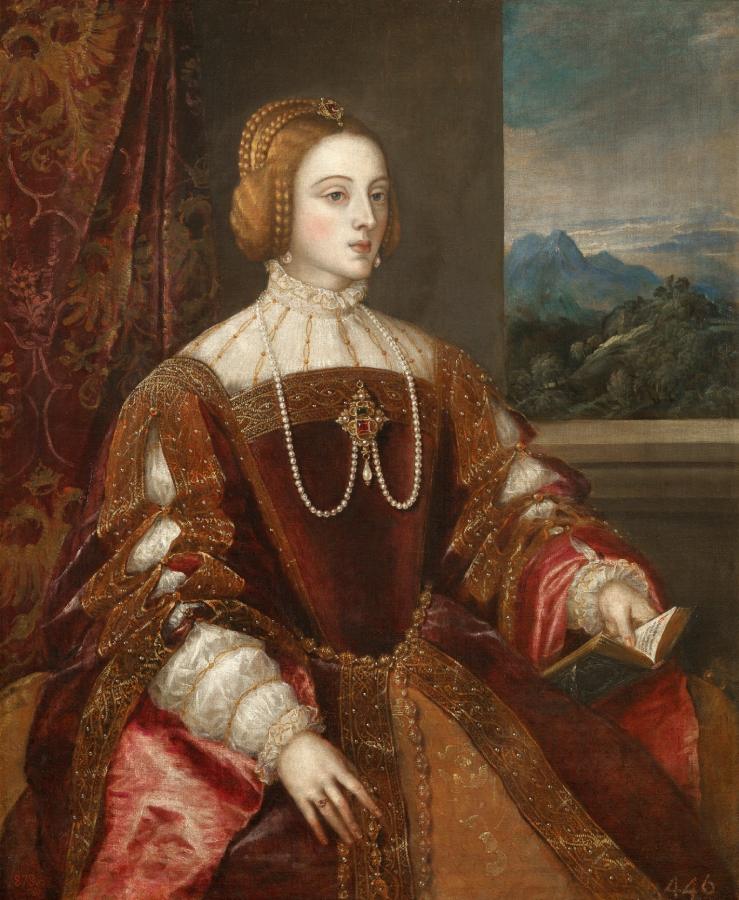Tiziano (c.1488-1576)
Ritratto di Isabella del Portogallo (Portrait of Isabella of Portugal)
1548
Oil on canvas, 117 cm x 98 cm
Museo del Prado, Madrid
The portraits that Titian painted of Isabella (1503-1539), daughter of King Manuel of Portugal and wife of Charles V from 1526, constitute one of the most moving episodes within Renaissance art. When the empress died, Charles found that he did not have her portrait, so he tried to recover the one that his deceased wife had sent years earlier to Margaret of Austria. In November 1539 he received this portrait from his sister Mary, but was not happy with it as he considered that it did not resemble his wife. It was probably at this point that he had the idea of commissioning a portrait from Titian if he could find a suitable model. In 1543 Charles sent to the artist in Busseto a small portrait of Isabella probably by William Scrots (Poznan, National Museum), ‘molto simile at vero, benché di trivial pennello’, according to Aretino. In 1545 Titian finished a portrait of Isabella dressed in black with flowers in her lap and with the imperial crown behind her; it was destroyed in the fire in the Palace of El Pardo in 1604 and is known through copies and prints. Charles had it brought to Augsburg in 1547 so that the artist could retouch the nose. This lost portrait acted as a model for the present version, also painted in Augsburg and which we know, from a letter from the artist to Granvelle, was completed on 1 September 1548. In the letters, Titian also refers to a double portrait of Charles and Isabella of which there is a copy by Rubens (Madrid, Fundacion Casa de Alba Collection), and which was a curious combination of the seated portrait of Charles (Munich, Alte Pinakothek) and the first one of the empress. These three portraits constitute further chapters in the fascinating process of the recovery of the empress through her image, culminating in the double portrait which united the emperor with his absent spouse. In these works Charles was not seeking a faithful reproduction of her appearance (given that he already had one molto simile al vero), but rather wished to visualise his own memorised one, which would explain the episode of the nose. Charles asked Titian to retouch this feature, not because it was badly painted, but rather because Titian had painted it as it really was. The portraits of Isabella made during her lifetime show her with an aquiline nose, a feature also remarked on by contemporary commentators, and not with the improbably straight and classically perfect nose which Titian painted. With this correction, Titian repeated with Isabella‘s nose the cosmetic operation he had carried out Charles‘ protruding jaw in his portraits. The moving, personal nature of the portrait explains why it was one of the few paintings that Charles always had with him, and it is documented in Brussels in 1556 and Yuste in 1558. The portrait follows a model by Raphael/ Giulio Romano (Isabel de Requesens; Paris, Louvre) which Titian had looked to in 1536 for his portrait of Eleonora Gonzaga, Duchess of Urbino. The sitter is seated with an open window next to her through which is a landscape. A sonnet by Pietro Aretino celebrating the portrait of Eleonora Gonzaga and the way in which the painter emphasises her virtues (her modesty in being seated and the purity implied by covering her breast and hair with a veil, elements also used for the empress), highlight the conventional nature of the formulae used in such images. Isabella‘s portrait, however, is more hieratic, not because she did not actually pose for it, but rather because it deliberately conveys a sense of distant majesty evident in other imperial portraits. It is not so much the imperial eagle embroidered on the curtain -the only concession to imperial iconography- but rather Isabella‘s distant gaze, focused neither on the Book of Hours that she holds or on a possible viewer, which gives her image gravity and dignity. The work is in good condition. The X-radiograph has revealed no alterations but has shown that Titian reused a canvas with a female figure painted on it. Philip II lent this portrait to his sister the empress Mary for the Descalzas Reales Convent, where it is mentioned by Carducho in 1633. In 1636 it was hanging in the Alcazar in Madrid, where it remained until the fire of 1734. It then passed to the Palacio Real Nuevo, entering the Museo del Prado in 1821. (Falomir Faus, Miguel, Tiziano, Madrid, Museo Nacional del Prado, 2003, p.208)
See also:
• Isabella of Portugal (1503-1539)
